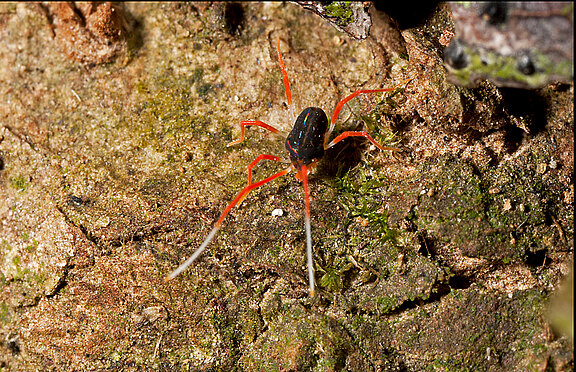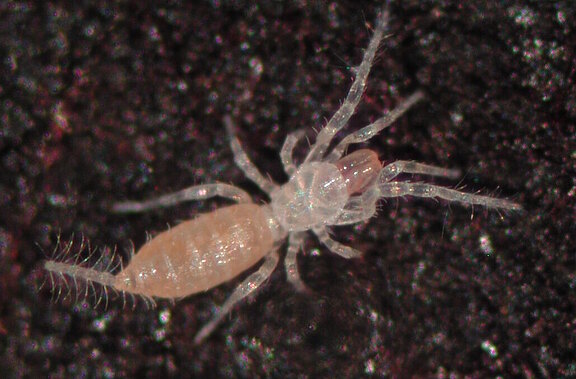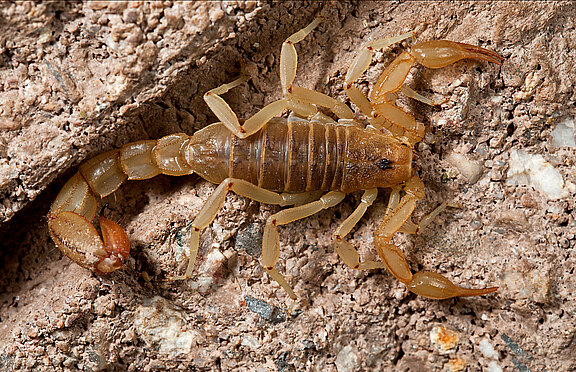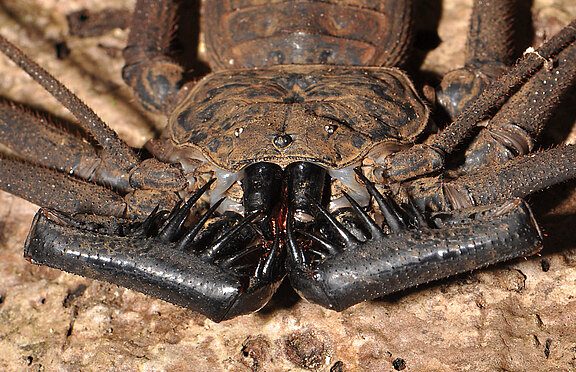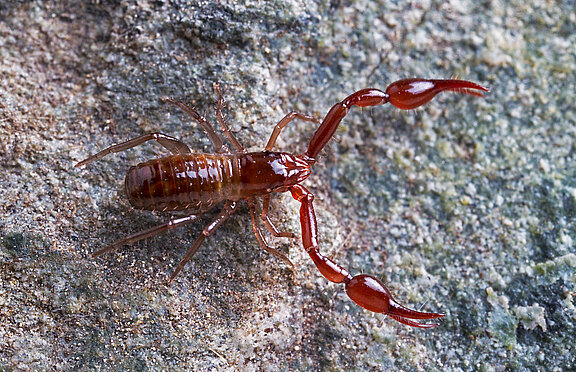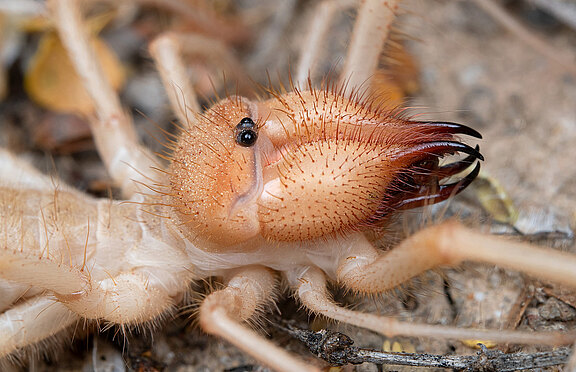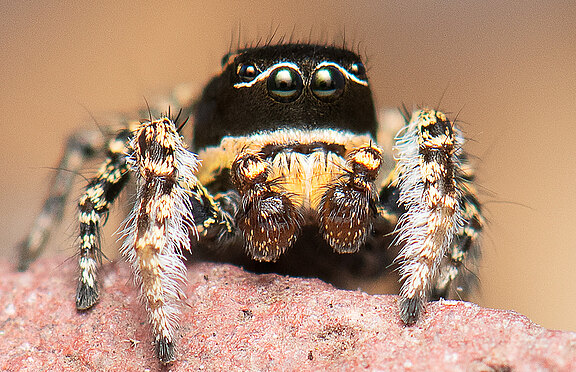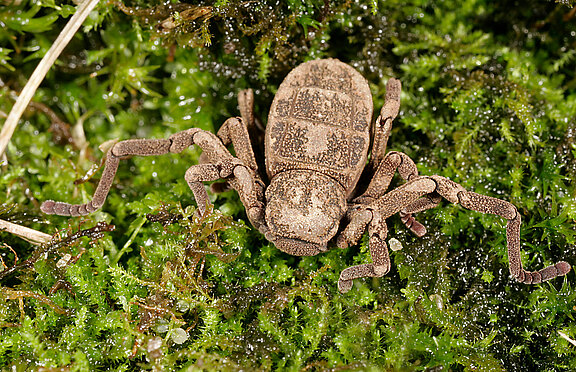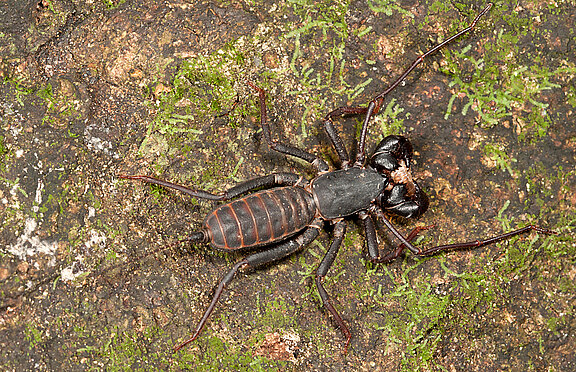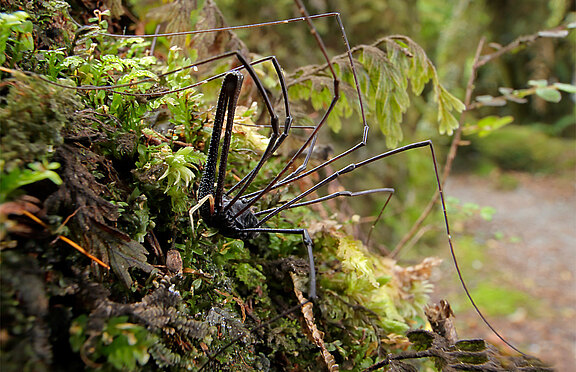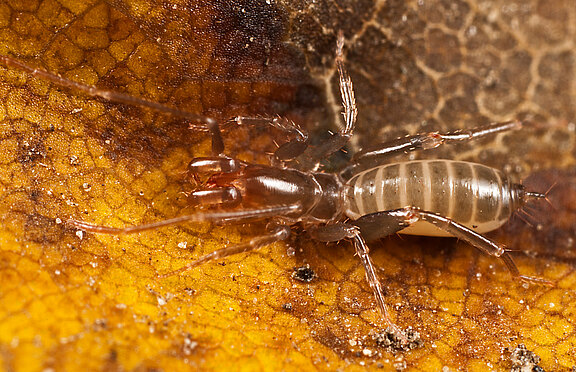List of all articles
Volume 50 Number 2
Araneae, predator diversity, vertebrate prey, prey-capture adaptations, physical strength, toxins, silk tensile strength
Abstract
According to a recent global literature survey, a total of 39 out of the 129 known spider families (∼30%) contain species capable of capturing vertebrate prey. The finding that the percentage of spider families engaged in vertebrate predation is so high is novel. Two groups of vertebrate-eating spiders are distinguished: “habitual vertebrate-eaters” vs. “occasional vertebrate-eaters”. The habitual vertebrate-eaters comprise ten spider families (Araneidae, Atracidae, Ctenidae, Lycosidae, Nephilidae, Pisauridae, Theraphosidae, Theridiidae, Trechaleidae, and Sparassidae) to which can be attributed 91% of all reported vertebrate predation incidents. The habitual vertebrate-eaters have evolved prey-capture adaptations such as (1) sufficient physical strength coupled with large body size, (2) the use of potent venoms, and (3) the use of highly efficient prey-catching webs. By contrast, unexpected feeding on vertebrates by the occasional vertebrate-eaters (i.e., Actinopodidae, Agelenidae, Amaurobiidae, Anyphaenidae, Barychelidae, Clubionidae, Corinnidae, Ctenizidae, Cyrtaucheniidae, Deinopidae, Desidae, Dipluridae, Eresidae, Filistatidae, Gnaphosidae, Haplonoproctidae, Linyphiidae, Liocranidae, Miturgidae, Oxyopidae, Pholcidae, Porrhothelidae, Salticidae, Selenopidae, Sicariidae, Sparassidae, Tetragnathidae, and Thomisidae) might be considered as chance events that took place when a tiny vertebrate crossed the path of an opportunistic spider. For a few families (e.g., Idiopidae) their status as habitual or occasional vertebrate predators is still unclear. In conclusion, our survey unveiled a large number of spider taxa previously not anticipated to feed on vertebrate prey. These findings improve our general understanding of spider feeding ecology and provide a first assessment of the significance of vertebrate prey as a food source for spiders.
Volume 50 Number 2
karst, South Korea, systematics, taxonomy, troglobite.
Abstract
South Korea is a country with more than 1000 caves that support a high diversity of invertebrate species. Here we review the pseudoscorpion genus Spelaeochthonius Morikawa, 1954 (family Pseudotyrannochthoniidae) that is exclusive to caves in Japan and South Korea and reinstated here as a valid taxon. Based on recent field collections, three species in this genus are described from South Korea: S. dentifer (Morikawa, 1970), comb. nov., S. cheonsooi sp. nov., and S. seungsookae sp. nov. Based on present-day knowledge about range sizes and morphological variability in this fauna, three Japanese taxa currently classified as subspecies are elevated to species rank: Pseudotyrannochthonius kobayashii akiyoshiensis (Morikawa, 1956) = Spelaeochthonius akiyoshiensis Morikawa, 1956, stat. nov., Pseudotyrannochthonius kobayashii dorogawanesis (Morikawa, 1956) = Spelaeochthonius dorogawaensis Morikawa, 1956, stat. nov.; and Pseudotyrannochthonius undecimclavatus kishidai (Morikawa, 1960) = Spelaeochthonius kishidai (Morikawa, 1960), stat. nov. We emphasize that no epigean Spelaeochthonius have ever been found despite considerable search effort in the forests of Japan and Korea, and that past glacial cycling may have resulted in the total extirpation of surface species in this lineage. We also note that all species are narrow-range endemics that may require conservation management.
Volume 50 Number 2
Tibetan Plateau, biogeography, psychrophilic, relict, systematics.
Abstract
The pseudotyrannochthoniid genus Centrochthonius Beier, 1931 is one of the rarest and most poorly understood pseudoscorpion genera in the world. Only a handful of specimens are presently known, all from high-altitude habitats in China, Kyrgyzstan and Nepal. The inaccessibility of specimens has resulted in major taxonomic difficulties such as a poor generic diagnosis, but also a lack of understanding of evolutionary patterns in this psychrophilic fauna. Herein we diagnose Centrochthonius for the first time since its original description and include four Holocene species: one from Kyrgyzstan, two from China, and C. anatonus sp. nov. from Nepal. A fifth fossil species from Bitterfeld amber (Oligocene-Miocene) in central Europe highlights significant range retraction and continental extinction in this genus since the Neogene, leading us to suggest a climatic relict hypothesis for this fauna. Biogeographically, the genus provides further evidence for significant range shifts and extinction events in the Holarctic invertebrate biota during the Cenozoic. Close relatives of Centrochthonius are found in subterranean habitats throughout eastern Asia and warm temperate forests in the western U.S.A. which highlights the magnitude of range retraction caused by climatic cycling in an ancient fauna since at least the Paleogene. The subgenus Allochthonius (Urochthonius) Morikawa, 1954 from caves in Japan has been largely defined by the presence of troglomorphic features such as eye loss, which are here regarded as insufficient to retain as a separate clade from other species of Allochthonius. Therefore, Allochthonius (Urochthonius) is treated as a junior synonym of Allochthonius (syn. nov.).
Volume 50 Number 2
Aposematic, Dinothrombium magnificum, distasteful, predation, cannibalism
Abstract
Giant velvet mites, the largest living mites, are a familiar sight when they are present above ground, usually after the first summer rains, in warm arid areas. Despite their often-conspicuous presence in enormous numbers, little is known about their basic biology, life history strategies, or predators. The emergence of Dinothrombium magnificum (LeConte, 1852) in southern Arizona, USA usually occurs after the first summer rain that exceeds 1 cm. Of the 17 species of vertebrate predators offered velvet mites, only those that quickly engulf their prey intact (horned lizards and toads) successfully preyed upon the mites. Even those ate only one or few before rejecting subsequent mites. Of the 12 species of insect predators and 11 species of other arthropod predators offered mites, only the larvae of antlions were possibly meaningful predators. Nevertheless, antlion larvae only rarely succeeded in puncturing the rubbery integument of a mite and killing it. When sampled by an author, a velvet mite produced an exceedingly bitter, astringent, and spicy taste that endured in the mouth for about an hour. Overall, velvet mites appear to have no meaningful predators, likely because of their enormous suite of highly effective defensives: red aposematic coloration, aposematic odor, a tough puncture-resistant integument, unpleasant tasting chemicals on the integument, and exceedingly distasteful internal compounds.
Volume 50 Number 2
Orb web, flexible construction behavior, behavioral evolution, damage from sagging
Abstract
Spider webs in general and orb webs in particular are delicate, ephemeral structures that are frequently damaged in nature. Some orb weavers respond to damage by quickly “shoring up” their webs with non-sticky dragline silk. This study of how Micrathena duodecimspinosa (O. Pickard-Cambridge, 1890) shores up damaged frame lines shows that repairs were largely based on a single, repeated pattern of attachments. These movements are shared with the distantly related family Pholcidae, suggesting a possibly ancient origin. Spiders tended to initiate repairs at the lower edge of a damaged sector, probably to reduce the damage produced when the spider's own weight caused sticky lines in slack portions of the web to sag into and adhere to each other. Repairs of lateral frames recuperated capture area more successfully than did those of upper frames, probably because damage caused by the spider's own weight during repair was reduced.
Volume 50 Number 2
Arachnida, Grassatores, Neotropics, morphology, sexual and male dimorphism.
Abstract
Rhaucoides Roewer, 1912 is herein revisited and re-diagnosed based on somatic and genital morphology, including the differences of both expanded and unexpanded glans complex shown for the first time in Cosmetidae. The genus is characterized mainly by abdominal ornamentation, coloration and by having the two basalmost tarsomeres of leg I fused. The genus Cumbalia Roewer, 1963 is newly considered a junior synonym of Rhaucoides. The species Cumbalia octomaculata Roewer, 1963, Rhaucoides festae Roewer 1925 and Rhaucoides sulfureus Mello-Leitão 1939 are considered junior subjective synonyms of Rhaucoides riveti Roewer, 1919. Erginus devillei Simon 1879 (currently in Metarhaucus) is transferred to Rhaucoides, resulting in Rhaucoides devillei (Simon 1879), comb. nov. Rhaucoides atahualpa sp. nov. and Rhaucoides nasa sp. nov. are described from Ecuador and Colombia, respectively. Comments about the genital and tarsal morphology in Cosmetidae are provided. A map with the known distribution of the genus, in the Andes of southern Colombia and northern Ecuador, is given. Finally, emended diagnoses are provided for the genera Rhauculus Roewer, 1927 and Reimoserius Roewer 1947. After the type species of Metarhaucus Pickard-Cambridge, 1905 was transferred to Rhaucus Simon, 1879, a few species remained without formal generic allocation. All of those are herein combined either with Rhaucoides (1 species), Rhauculus (5 species) or Reimoserius (1 species).
Volume 50 Number 2
Arachnida, endemic species, morphology, taxonomy, Afrotropical region, western Asia
Abstract
Two new pseudoscorpion species, Neobisium (Ommatoblothrus) wettereri Nassirkhani sp. nov. and Neobisium (Ommatoblothrus) karmanae Nassirkhani sp. nov., are described from Socotra (Yemen). The family Neobisiidae is reported for the first time from Socotra. Ecological notes on these two new species and a distribution map of all known Neobisium (Ommatoblothrus) species are presented.
Volume 50 Number 2
Assassin spider, biogeography, conservation, Palpimanoidea, phylogeny, taxonomy
Abstract
Two new species of pelican spiders (family Archaeidae) are described from rainforest habitats in south-eastern Queensland, Australia – Austrarchaea davidi Rix, sp. nov. and A. laidlawae Rix, sp. nov. – and the female of A. clyneae Rix & Harvey, 2011 is described for the first time. Phylogenetic analysis of a mitochondrial molecular dataset for the genes cytochrome c oxidase subunits I and II reveals that these two new species are the closest relatives of A. judyae Rix & Harvey, 2011 and A. clyneae, respectively, with mitochondrial sequencing also used to identify newly-collected specimens of Austrarchaea from populations throughout south-eastern Queensland. These recent collections were largely made during dedicated survey work conducted after the devastating 2019–20 summer bushfires in eastern Australia. We further provide a synopsis of the archaeid fauna of south-eastern Queensland, which is comprised of 11 species in two monophyletic regional-endemic clades. A revised key to species is presented for both clades, along with updated distributional information, and live habitus images for nine of the 11 species.
Volume 50 Number 2
Myrmecophage, Zodarion, Novomessor, Pogonomyrmex, ant guest
Abstract
The spider Myrmecicultor chihuahuensis Ramírez, Grismado & Ubick (Myrmecicultoridae) was described in 2019 and hypothesized to be a myrmecophile, living inside the nests of Novomessor (Myrmicinae) and perhaps also Pogonomyrmex (Myrmicinae) ants. To test the hypothesis that M. chihuahuensis are chemical mimics of their host ants, we carried out behavioral bioassays to observe interactions between the spiders and the host ants. We compared the cuticular hydrocarbon (CHC) profiles of the spiders and the ants. We discovered that this new species of spider is a myrmecophage, displaying hunting strategies similar to other myrmecophagous spiders, particularly those in the genus Zodarion Walckenaer, 1826 (Zodariidae). The CHC profile of M. chihuahuensis did not match the profile of the ants with which it associates, Novomessor albisetosus (Mayr), but ants and spider shared several compounds, potentially involved in species recognition.
Volume 50 Number 2
Group living, social evolution, cooperative hunting
Abstract
Sociality in spiders has evolved independently multiple times, resulting in convergently evolved cooperative breeding and prey capture. In all social spiders, prey is captured by only a subset of group members and then shared with other, non-attacking group members. However, spiders' propensity to attack prey may differ among species due to species-specific trade-offs between risks, costs and benefits of prey capture involvement. We explored whether engagement in prey attack differs among three social Stegodyphus species, using orthopteran prey, and found substantial differences. Stegodyphus mimosarum Pavesi, 1883 had a low prey acceptance rate, was slow to attack prey, and engaged very few spiders in prey attack. In S. sarasinorum Karsch, 1892, prey acceptance was high, independently of prey size, but more spiders attacked when prey was small. While medium-sized prey had higher acceptance rate in S. dumicola Pocock, 1898, indicating a preference, the number of attackers was not affected by prey size. Our results suggest that the three species may have different cooperative prey capture strategies. In S. mimosarum and S. dumicola, whose geographical ranges overlap, these strategies may represent niche specialization, depending on whether their respective cautious and choosy approaches extend to other prey types than orthopterans, while S. sarasinorum may have a more opportunistic approach. We discuss factors that can affect social spiders' foraging strategy, such as prey availability, predation pressure, and efficiency of the communal web to ensnare prey. Future studies are required to investigate to which extent species-specific cooperative foraging strategies are shaped by ontogeny, group size, and plastic responses to environmental factors.
Volume 50 Number 1
Chapada Diamantina, Cteninae, subterranean biology, troglobitic
Abstract
In this work we describe Ctenus igatu sp. nov., the first ctenid spider from South America with conspicuous troglomorphic traits, including elongated appendages, reduction of eyes, and body depigmentation. The new species is only known to occur in a unique sandstone cave from the state of Bahia, north-eastern Brazil. The morphology of the genitalia suggests that Ctenus igatu sp. nov. is closely related to Ctenus fasciatus Mello-Leitão, 1943, a facultative subterranean species from caves in the state of São Paulo, south-eastern Brazil. In addition, we compared morphological traits possibly related to the isolation in subterranean habitats, such as ratios between carapace length vs. leg IV length and eye diameters vs. carapace length, of 19 species of Ctenus (17 epigean species, C. fasciatus and the new troglobitic species described herein). Our analysis showed that both C. fasciatus as C. igatu sp. nov. have morphological troglomorphisms, with C. igatu sp. nov. showing marked specializations to subterranean life.
Volume 50 Number 1
Sex chromosomes, high diploid numbers, Araneae, spiders, Araneoidea.
Abstract
The Araneidae is among the most speciose spider families, but there are few karyotype studies (1.9%) and some species-rich clades are without any chromosomal study. Understanding the evolution of chromosome number and Sex Chromosome Systems is made more difficult by many uncertain evolutionary relationships within the family. In this work, the chromosomal analysis of eight araneid species (Acacesia benigna Glueck, 1994, Actinosoma pentacanthum (Walckenaer, 1841), Alpaida bicornuta (Taczanowski, 1878), Dubiepeira Levi, 1991 sp., Gasteracantha cancriformis (Linnaeus, 1758), Parawixia bistriata (Rengger, 1836), Verrucosa meridionalis (Keyserling, 1892) and Verrucosa scapofracta Lise, Kesster & Silva, 2015), contribute to discussions of some evolutionary scenarios of chromosome evolution. The gonads were submitted to colchicine treatment, hypotonization, slide preparation, and Giemsa staining. The species analyzed showed 2n♂ = 24 (11II + X1X2), except Dubiepeira sp. with 2n♂ = 41 (19II + X1X2X3), and both Verrucosa species, which presented 2n♂ = 47 (22II + X1X2X3) in V. meridionalis and 2n♂ = 50 (23II + X1X2X3X4) in V. scapofracta. The species analyzed possess all chromosomes with acro/telocentric chromosomal morphology. The 2n♂ = 24, X1X2 found in most species studied here is the most frequent karyotype in the Araneidae. This study presents the first chromosomal data for the diverse clade “Micrathenines”, the highest diploid number among entelegynes (2n♂ = 50), and the first record of an X1X2X3X4 in the Araneidae. The chromosome data suggest a series of fission events in the origin of Verrucosa karyotypes, and a close relationship between Dubiepeira sp. and Araneus ventricosus (L. Koch, 1878). Moreover, Alpaida bicornuta can be cytotaxonomically distinguished of other Alpaida species karyotyped up to now.
Volume 50 Number 1
Movement, emigration, habitat preference, pitfall traps
Abstract
We studied dispersal of brown recluse spiders, Loxosceles reclusa (Gertsch & Mulaik, 1940), around an infested urban garage using pitfall traps. Over a four-month period, 23 were captured from a source population that averaged 100 individuals observed in nocturnal censuses. Loxosceles reclusa were captured in far lower proportions compared to their potential source population size than were other spiders such as theridiids and agelenids that also resided in the garage, albeit in far lower numbers. Dispersal was weakly positively correlated with the source population size. We compare our findings to anecdotal reports from prior studies and the general consensus that brown recluse spiders are poor dispersers to argue for more detailed examination of the movement and specific habitat requirements of this medically important spider. Habitat specificity and high mortality during dispersal may help explain the highly clustered spatial distribution of brown recluse spiders, not only a lack of attempted emigration.
Volume 50 Number 1
Reproductive biology, geographic parthenogenesis, sexual populations
Abstract
Parthenogenesis and sex-ratio bias may lead to erroneous assumptions concerning the natural history of some arachnids. To help address this issue, this study provides new data on the sex ratio and geographic distribution of sexual populations of the scorpion Tityus stigmurus (Thorell, 1876). Ultraviolet light lanterns were used to detect specimens during nocturnal searches performed in both urban and non-urban environments scattered thorough northeastern Brazil. Males of T. stigmurus were reported for 10 new localities, and although we did not find males in urban environments, non-urban populations presented near symmetrical sex ratios. Such results suggest that reproductive strategies in this species may be modulated by environmental conditions. Also, the general tendency of less biased sex ratios in non-urban environments reported here is in accordance with previous studies that indicated the occurrence of geographical parthenogenesis in this species. Thereby, we propose that sexual populations of T. stigmurus are less rare than previously reported.
Volume 50 Number 1
Araneae, biological traits, functional diversity, geographical range, taxonomy.
Abstract
Online open databases are increasing in number, usefulness, and ease of use. There are currently two main global databases for spiders, the World Spider Catalogue (WSC) and the World Spider Trait (WST) database. Both are regularly used by thousands of researchers. Computational tools that allow effective processing of large data are now part of the workflow of any researcher and R is becoming a de facto standard for data manipulation, analysis, and presentation. Here we present an R package, arakno, that allows interface with the two databases. Implemented tools include checking species names against nomenclature of the WSC, obtaining and mapping data on distribution of species from both the WST and the Global Biodiversity Information Facility (GBIF), and downloading trait data from the WST. A set of tools are also provided to prepare data for further statistical analysis.
Volume 50 Number 1
Anyphaenidae, Cheiracanthiidae, Oxyopidae, Salticidae, Egg predation, Invertebrata, Anura, Squamata
Abstract
In this paper, we present an update on our knowledge on egg predation (oophagy) by spiders. Based on a survey of 233 reports, ghost spiders (Anyphaenidae), lynx spiders (Oxyopidae), jumping spiders (Salticidae), and yellow sac spiders (Cheiracanthiidae) were the most prominent groups of spiders engaged in oophagy. Around 75% of the reports referred to the consumption of lepidopteran and spider eggs worldwide. Another 10% referred to the consumption of eggs/embryos of anurans – especially predation upon embryos of glass frogs (Centrolenidae) by spiders from the families Anyphaenidae and Trechaleidae in the Neotropics. The remaining 17% included rare instances of feeding on eggs of coleopterans, dermapterans, dipterans, heteropterans, homopterans, hymenopterans, acarids, neuropterans, opilionids, and squamates. Our study demonstrates that oophagy in spiders is much more widespread than previously thought, both geographically and taxonomically. The finding that spiders feed on eggs/embryos from so many different invertebrate and vertebrate taxa is novel.
Volume 50 Number 1
Arachnida, genetics, morphology, Pseudoscorpiones, Macaronesia
Abstract
Pseudoscorpions are known worldwide and yet are poorly studied mainly due to the difficulty of detecting them. Among their predators are ground-dwelling taxa, such as arthropods, amphibians, birds, and reptiles. Only four pseudoscorpion species are known to occur in the Cabo Verde Archipelago, and none in the Desertas Islands, located in the northwest of the country. In this study, we record the first two species for the Desertas Islands. We used molecular and morphological methods to taxonomically identify the specimens retrieved from reptile faecal pellets and pitfall traps. We identified the presence of Garypus cf. saxicola on Raso Islet, Olpium pallipes (Lucas, 1849) on Raso and Santa Luzia Island, and a putative new species of Olpium L. Koch, 1873 on Branco Islet. This study emphasizes how an indirect measure of biodiversity and ecological interactions via potential predators, using non-invasive sampling combined with metabarcoding and morphological studies, can be used to uncover unknown biodiversity, particularly of cryptic groups from highly inaccessible locations. Likewise, this study highlights the lack of 16S genetic resources for pseudoscorpions in online reference databases.
Volume 50 Number 1
Modisimus bribri, Modisimus guatuso, prey capture, web dimensions.
Abstract
The pholcid spiders Modisimus bribri Huber, 1998 and M. guatuso Huber, 1998 construct three-dimensional webs, including sheet dome and irregular shapes, occasionally shared by males and females. We studied species spatial disaggregation and confirmed web-sharing and prey capture dominance in shared webs. We observed 22 M. bribri and 25 M. guatuso webs and recorded their height above the ground, dome dimensions, and web-sharing. In shared webs, we recorded which individual captured prey. Modisimus bribri builds webs at greater heights (∼6.5 times), with larger dimensions (∼2 times) than M. guatuso. In both species, neither the occupant sex nor the number of individuals on the web had a significant effect on web dimensions. We confirmed differential web location between species and did not find evidence of chivalrous dominance in prey-capture in shared webs. This study contributes to the general knowledge of three-dimensional web-building spiders, posing new questions for future research.
Volume 50 Number 1
Camel spider, mark-and-recapture, philopatry.
Abstract
Many animals, including many arachnids, return to an established “home” after an active period. Although desert-adapted solifuges shelter from the sun in retreats, it is unknown if these solifuges “home” to and re-use the same retreats over multiple consecutive periods. We sought to investigate whether individual solifuges exhibit site fidelity (philopatry) and could be found repeatedly within the same small geographic area using a simple mark-and-recapture study design. Over the course of the seven-day study period, nine of 46 solifuges were recaptured once, and two were recaptured a second time, with an average of 4.17 m between encounters. This rate of recapture is suggestive that solifuges remain in or return to the same geographic area over some period of time – a prerequisite for homing behavior. Further investigation is warranted to establish if solifuges are repeatedly using the same retreats, and if so, how they are navigating during homing.
Volume 50 Number 1
Koinobiontism, spider host, host-parasitoid interaction, host range, life strategy
Abstract
The ichneumonid parasitoid Sinarachna nigricornis (Holmgren, 1860) was associated only with Araneus sturmi (Hahn, 1831) in the studied locality. The normal capturing orb web of A. sturmi was always vertical and had a median of 18 radii and 9 spirals in laboratory conditions. When spiders did not build capture webs, they built resting and molting webs which consisted of a few threads between the ends of the provided tree twigs. There were no significant differences in the number of radials and spirals between unparasitized spiders and spiders parasitized by early instar parasitoid larvae. Araneus sturmi under manipulation by S. nigricornis built a modified cocoon web, serving parasitoid larva pupation. S. nigricornis exhibited high plasticity in the architecture of the cocoon web induced by its penultimate instar larva. The most common cocoon web was of 3D architecture with a small central silk platform, from which the wasp cocoon was suspended by its apical end (72% of webs). In 22% of cases, the cocoon web consisted only of a few threads, presumably resembling a molting web. In one case, the manipulated spider built a 3D tangle, though radials and the central hub (typical for the normal capturing web) were also present. The genus specificity of the cocoon web architecture described here, in which the typical cocoon web exhibits a sparse but strong 3D architecture and in which the wasp cocoon is suspended by its apical end at the center, is expected for the genus Sinarachna.
Volume 50 Number 1
polygamy, experience, mating system, sexual conflict, sexual size dimorphism
Abstract
Sexual cannibalism is common in many species of arachnids. Studies investigating Dolomedes tenebrosus Hentz, 1844, have even discovered the occurrence of obligatory male self-sacrifice during copulation. In this system, females subsequently cannibalize males, and this cannibalism leads to higher fitness for both partners. Unfortunately, our understanding of the evolution of such an extreme mating system is challenged by the absence of information for close relatives. To that end, this study explores the courtship behavior, mating system and cannibalism dynamics of the spider Dolomedes scriptus Hentz, 1845. To determine whether female and male D. scriptus mate multiply, we recorded interactions of repeatedly exposed focal females and focal males to new mating partners for three days. We also quantified attacks and cannibalism events that occurred both before and after every copulation. We found male D. scriptus court females by waving their forelegs during their approach and tapping the females prior to mounting. In our remating trials, none of the female D. scriptus accepted additional males after their first mating over the three-day period. In contrast, male D. scriptus were polygynous, often mating with multiple females. Across the trials, sexual size dimorphism was a predictor of whether mating occurred, with similarly sized pairs being more likely to mate. Additionally, previously mated females were less likely to cannibalize males—an unusual pattern for spiders. Like other species of Dolomedes Latreille, 1804, our results suggest a strong role of female aggression in D. scriptus mating system dynamics.
Volume 50 Number 1
Long-jawed spiders, sympatric species, reproductive isolation, pre-mating recognition
Abstract
Species recognition and reproductive isolation are critical for organisms to prevent expensive and unsuccessful matings. This may be particularly important in closely related species that coexist synchronously in the same habitat, and for which reproductive barriers are not entirely effective. Tetragnatha argentinensis Mello-Leitão, 1931 and T. nitens (Audouin, 1826) are two long-jawed orb weaver spiders whose feeding grounds and reproductive phenology overlap extensively. Since general patterns of sexual behavior observed in the field showed no apparent differences between these two species, we proposed to evaluate the occurrence of heterospecific mating, and explored the occurrence of potential reproductive isolation mechanisms between them by analyzing in fine scale the mating behaviors of each species and sex. We observed only one heterospecific mating, and few or no sexual interactions occurred in other crossed trials. We found that both species showed similar general mating patterns, however, there are some subtle differences between them. In T. nitens, males clasped the female's chelicerae with their own, but the opposite occurred in T. argentinensis. Moreover, males of T. nitens produced fewer hematodochal inflations, lower number of flubs, and shorter insertions than males of T. argentinensis. Females of T. argentinensis vibrated their abdomen at a higher rate. Our results indicate that these sympatric Tetragnatha species have successful reproductive isolation that probably takes place through recognition mechanisms occurring prior to mating. We provide an update on the taxonomic status of T. argentinensis and its distribution, and a new junior synonymy.
Volume 50 Number 1
Courtship, copulation, female quiescence, sperm induction
Abstract
There are few works on the reproductive behavior of species of cribellate spiders. Even more scarce are studies of the reproductive behavior of representatives of the Desidae, such as the genus Metaltella Mello-Leitão, 1931. In this paper, we describe for the first time the reproductive behavior of Metaltella iheringi (Keyserling, 1891), a species that is characterized by complex genitalia in both sexes. We determined frequencies and durations of the behaviors in the different phases. Thirty virgin males were exposed to virgin females and the behaviors performed by each sex, as well as their frequencies, were recorded. Three phases were identified: pre-copulatory, copulatory, and post-copulatory. The most frequent behaviors were chelicera-palp rubbing, abdomen vibration and web-stretching by the male, and body-shaking and leg-tapping on the web by the female. When the male grabbed the female, she typically fell into a state of quiescence (the female remained motionless with legs in a semi-flexed position) and she remained so even after the male ended the copulation. Mating was characterized by low aggression by the female and a low incidence of cannibalism. In the post-copulatory phase, the male performed frequent behaviors such as abdomen vibration, sperm induction, and post-copulatory cohabitation. We discuss the possible implications of these behaviors in a pre- and post-copulatory sexual selection context. We also provide information that serves as a basis for future studies to understand the mechanisms involved in these behaviors.

